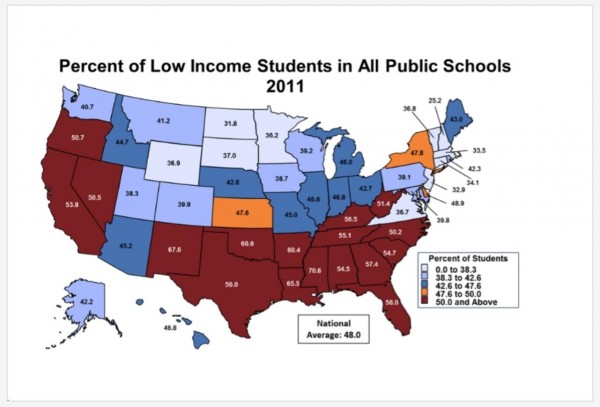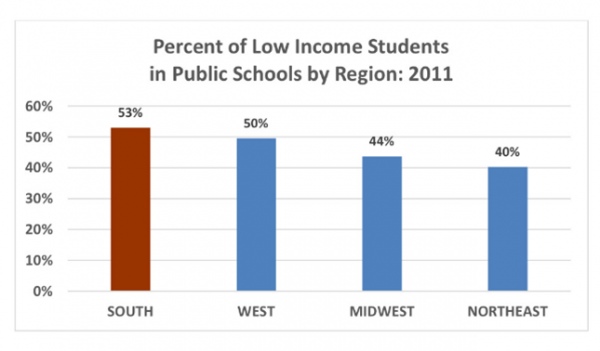Majority of Students in 17 States Are Low Income, Study Finds; Connecticut Schools Among Most Income Diverse, Except in Cities
/
Echoing concerns that “a house divided against itself cannot stand,” a new study is raising alarm about the dramatically increasing percentage of low income students in American public schools – and the implications for the education of a generation of school children.
A new study from the Southern Education Foundation shows that 17 U.S. states have reached an unenviable tipping point: the majority of students in their public school systems receive free lunches — effectively indicating that the public school systems in these states can now be described as institutions that mostly serve the poor, rather than public institutions that serve a representative cross-section of their state’s population.
As states coast-to-coast reach that new imbalance – particularly in the South and West – the Northeast, including Connecticut, continue to have the smallest percentages of low income students in their public schools, according to the most recent data used in the study, from 2011. The states with majority-poor school systems include almost the entire South, as well as Oregon, Nevada, and California.
The study pointed out that “from 2001 through 2011, the numbers of low income students in the nation’s public schools grew by 32 percent – an increase of more than 5.7 million children. As a result, low income students attending the nation’s  public schools moved from 38 percent of all students in 2001 to 48 percent in 2011.”
public schools moved from 38 percent of all students in 2001 to 48 percent in 2011.”
In Connecticut, the percentage of low income students in public schools was only 34 percent, among the lowest percentages in the nation. Only four states had a lower or equal percentage – New Hampshire (25%), North Dakota (32%), New Jersey (33%) and Massachusetts (34%).
The largest percentage of low income students were in Mississippi (71%), New Mexico (68%), Louisiana (66%), Oklahoma (60%), Arkansas (60%), Georgia (57%), Kentucky (57%), Florida (56%), Alabama (55%), Tennessee (55%), South Carolina (55%) and California (54%).
Overall, the rates of low income students in the public schools, by region, was 53 percent in the South, 50 percent in the West, 44 percent in the Midwe st and 40 percent in the Northeast. The national average was 48 percent. As the report pointed out, “in 2011 the nation stood within only two percentage points of enrolling a majority of low income students in public schools across 50 states.”
st and 40 percent in the Northeast. The national average was 48 percent. As the report pointed out, “in 2011 the nation stood within only two percentage points of enrolling a majority of low income students in public schools across 50 states.”
The study also compared the rates of low income students in cities, suburbs and rural areas in each state. In each of the nation’s four regions, a majority of students attending public schools in the cities were eligible for free or reduced lunch.
The Northeast had the highest rates for low income school children in cities: 71 percent. The next highest rate, 62 percent, was found in Midwestern cities. The South had the third highest percentage of low income students in the cities – 59 percent. In Connecticut, 62 percent of students in the cities were low income students, compared with 26 percent in the suburbs and 13 percent in rural areas.
“Low income students are concentrated in the nation’s cities but are by no measure confined to only cities,” the study noted. “Forty percent or more of all public school children in the nation’s suburbs, towns and rural areas are low income students.”
 The report, released in October 2013, indicated that low income students “generally are more likely to score lowest on school tests, fall behind in school, fail to graduate, and never receive a college degree,” and yet “the growth in the number of low income students far out-stripped the growth in per pupil spending in public schools during the last decade in every region of the country, except the Northeast.” The nations per pupil expenditure (adjusted for inflation) in public schools increased by only 14 percent – less than half the rate of growth in the numbers of low income students,” according to the report.
The report, released in October 2013, indicated that low income students “generally are more likely to score lowest on school tests, fall behind in school, fail to graduate, and never receive a college degree,” and yet “the growth in the number of low income students far out-stripped the growth in per pupil spending in public schools during the last decade in every region of the country, except the Northeast.” The nations per pupil expenditure (adjusted for inflation) in public schools increased by only 14 percent – less than half the rate of growth in the numbers of low income students,” according to the report.
The study concludes by stating that “The trends of the last decade strongly suggest that little or nothing will change for the better if schools and communities continue to postpone addressing the primary question of education in America today: what does it take and what will be done to provide low income students with a good chance to suc ceed in public schools? It is a question of how, not where, to improve the education of a new majority of students.”
ceed in public schools? It is a question of how, not where, to improve the education of a new majority of students.”
The Southern Education Foundation’s mission is to advance equity and excellence in education for low income students and students of color. The Foundation’s “core belief is that education is the vehicle by which all students get fair chances to develop their talents and contribute to the common good.”





























